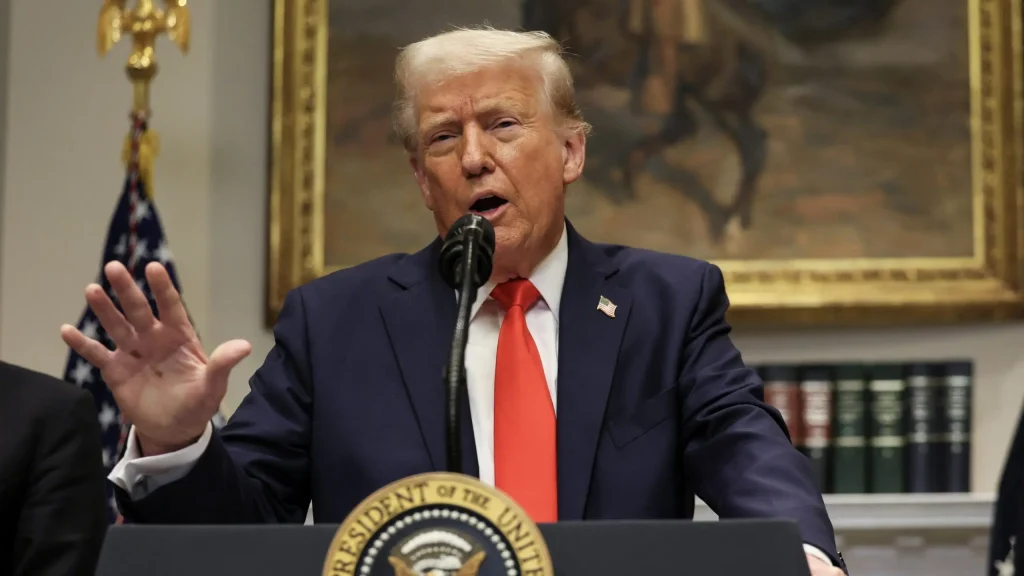In recent polling conducted by Quinnipiac University, President Donald Trump finds himself in a challenging position just eight weeks into his second term. With an approval rating of 42% against a disapproval rating of 53%, public opinion appears increasingly divided on his presidency. This shift in sentiment reflects growing discomfort among voters regarding Trump’s handling of critical issues such as the economy and foreign policy.
The latest data highlights critical trends affecting Trump’s presidency and the implications for his administration as it navigates a complex political landscape. While he promotes efforts to lower federal spending and streamline government, the response from citizens shows significant disapproval, suggesting a potential uphill battle in his attempts to fulfill campaign promises.
| Article Subheadings |
|---|
| 1) President’s Approval Rating Dips |
| 2) Divisions Among Voters |
| 3) Economic Concerns and Public Sentiment |
| 4) The Role of the Department of Government Efficiency |
| 5) Political Implications of Recent Polling Data |
President’s Approval Rating Dips
Recent polling results from Quinnipiac University indicate that President Donald Trump‘s approval rating has experienced a notable decline. Conducted from March 6 to 10, the survey reveals a 42% approval rate compared to a 53% disapproval rating among registered voters nationwide. This marks a decrease from a prior poll in late January immediately following his inauguration, when Trump enjoyed a 46% approval rating. This significant shift suggests an unsettling trend as the administration ramps up its policy initiatives. The drop in approval is associated with growing public dissatisfaction with the president’s management of various critical issues, thereby complicating his efforts to rally support.
Divisions Among Voters
Voter sentiment regarding President Trump’s performance is starkly polarized. The Quinnipiac survey indicates a pronounced partisan divide, with 96% of Democrats expressing disapproval while 89% of Republicans approve of his job performance. Independent voters exhibit significant discontent, with a 58% disapproval rate vs. 36% approval for the president. Such deep divisions demonstrate how Trump’s governing style and policy choices continue to resonate differently across the diverse political spectrum, potentially hindering bipartisan support for his administration’s initiatives.
Economic Concerns and Public Sentiment
As the economy remains a crucial issue for Americans, Trump’s handling of economic matters has come under fire from voters. In the recent Quinnipiac poll, Trump’s approval rating on economic issues stands at a concerning 41%, with 54% disapproval. Despite the prior electoral success he enjoyed on an economics-centric campaign, recent polling signals a troubling trend where public dissatisfaction could jeopardize his agenda. Analysts attribute this worsening perception to various factors, including inflation and job market uncertainties, which have overshadowed the administration’s economic messaging.
The Role of the Department of Government Efficiency
In an attempt to recalibrate public perception and streamline government operations, President Trump established the Department of Government Efficiency (DOGE), appointing tech mogul Elon Musk at its helm. The DOGE’s mission revolves around eliminating wasteful spending and reducing the size of the federal workforce. However, these efforts have met with significant public backlash, with 60% of poll respondents disapproving of how Musk and DOGE handle federal employees. Concerns are predominant among voters that the aggressive downsizing of government roles could jeopardize essential public services.
Political Implications of Recent Polling Data
The implications of the latest polling are far-reaching for Trump’s presidency as it navigates through the complexities of governance. The data reflect a growing disenchantment among constituents that can complicate legislative efforts and potential re-election strategies. With a significant portion of the electorate disapproving of his handling of the economy and other critical issues, Trump faces an uphill battle in consolidating his base and expanding his appeal to other voter segments. The stark division in approval ratings also raises questions about the potential impact such polling data may have on the administration’s overall effectiveness moving forward.
| No. | Key Points |
|---|---|
| 1 | President Trump’s approval rating is currently at 42%, down from 46% since his inauguration. |
| 2 | Significant partisan divides show overwhelming disapproval among Democrats and strong support from Republicans. |
| 3 | Economic concerns, a key issue for voters, have led to declining approval ratings for Trump’s handling of the economy. |
| 4 | The establishment of the Department of Government Efficiency has faced backlash for its aggressive downsizing strategies. |
| 5 | The current polling trends indicate challenges for the Trump administration in terms of governance and re-election prospects. |
Summary
The latest polling data unveils a precarious situation for President Trump’s administration, as approval ratings reflect growing discontent among the electorate. With pronounced divisions among voters and particular vulnerabilities surrounding economic management and federal workforce issues, the Trump administration must navigate a complex landscape fraught with challenges that could hinder its policy initiatives. As public dissatisfaction rises, understanding voter sentiment will be crucial as the administration seeks to re-establish favor with a broad cross-section of the American public.
Frequently Asked Questions
Question: What do the recent polls indicate about President Trump’s approval ratings?
The recent polls indicate that President Trump’s approval ratings have dipped to 42%, with 53% disapproval, reflecting a growing dissatisfaction among the electorate in various areas, particularly regarding economic management.
Question: How does public opinion vary among different political parties regarding Trump’s performance?
Public opinion varies significantly, with 96% of Democrats disapproving of Trump’s performance, 89% of Republicans approving, and independent voters showing a 58% disapproval rate.
Question: What is the function of the Department of Government Efficiency established by President Trump?
The Department of Government Efficiency, led by Elon Musk, aims to reduce wasteful federal spending and downsize the federal workforce. However, its aggressive tactics have resulted in significant public backlash.
